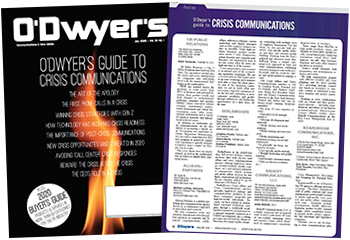 |
| Ashley McCown and T.J. Winick co-authored this article. |
Your organization is facing a serious threat. Its reputation—and perhaps its very existence—hang in the balance.
Having shepherded clients across sectors and industries through hundreds of crises, we have witnessed the time, energy and resources it takes for leadership to respond effectively at these pivotal moments. While advance planning helps inoculate your leadership team against some of these costs, the demands of an unfolding crisis can easily derail a chief executive’s daily schedule.
While the CEO should oversee or designate a senior team member to manage the situation, the question of who should communicate to internal and external audiences, i.e., to manage the perception of the organization during a crisis, is a topic of much debate. Just as there is no single strategy for how to respond to these urgent matters; the role of your CEO at these moments of truth is complex and often dynamic, with the need to adapt in real-time to an ever-changing reality.
 |
| This article is featured in O'Dwyer's Jan. '20 Crisis Communications Magazine. |
There are several factors that determine whether or not your CEO should be the chief spokesperson in a crisis. Here are five considerations, along with some real-life examples that demonstrate their importance:
Ability to relate: This should be the determining factor for most organizations: Is your CEO relatable, and if not, can training help? In a crisis, the CEO needs to communicate “we get it” by projecting empathy and compassion; but don’t assume communicating effectively under pressure is a skillset every leader possesses. Relatable may also mean understanding the culture of a different geographic region or country where an incident occurred. If the CEO doesn’t speak the language, literally or figuratively, it’s likely best to go with someone who is more relatable to those local audiences who matter most.
Teachable moment: The often-cited example of a CEO who failed to communicate empathy is BP’s Tony Hayward who uttered, “I just want my life back,” during the Gulf Oil Spill of 2010. However, there are many more examples of CEOs saying the wrong thing—or, equally as bad, nothing at all—at the wrong time. When a United Airlines passenger was dragged from his seat and bloodied aboard a 2017 flight because he refused to get off a plane that was overbooked, a passenger video of the incident went viral. United’s CEO was then predictably condemned when his statement read, in part, “I apologize for having to re-accommodate these customers.” The language smacks of legalese, and lacks empathy for the injured passenger, or remorse for how he was treated by the airline.
Read and react: First, ensure the crisis is of a certain magnitude; having the CEO be public-facing for a minor crisis risks overexposure and can even escalate that minor situation into a major one in the eyes of your key stakeholders. At the same time, when there’s a crisis in which the CEO must act as spokesperson, make sure he/she is seen and heard from at the appropriate moment(s). Waiting days or even weeks to comment only leads to the appearance that they were pressured or publicly shamed into commenting when they finally do.
Teachable moment: Facebook’s Mark Zuckerberg was roundly criticized when he neglected to comment for weeks after a crazed and hate-filled gunman livestreamed his New Zealand mosque attacks on the social network. Because the CEO didn’t speak about the shooter using Facebook as a platform to broadcast his attacks—or what safeguards can be put in place to prevent such disturbing content—he and his company were perceived as insensitive and uncaring. Remember that tragedies, especially involving fatalities, will almost always require an expression of sympathy and remorse by the CEO and a vow to never let whatever took place happen again.
Subject matter expertise: If the CEO doesn’t have a depth of knowledge in the area at the heart of your organization’s crisis, then he/she will presumably have a hard time sufficiently answering all the questions the press may have. At these moments, the CEO still needs to be visible to acknowledge that he or she is on top of the situation, while allowing those with the technical expertise (perhaps outside agencies like law enforcement or the NTSB) to address the specifics of what happened and what steps are being taken to resolve the situation.
Teachable moment: When an alligator pulled a child underwater at Disney World in 2015, tragically resulting in the boy’s death, all eyes were on the search to find the child and, on how Disney responded. While its Chairman, Bob Iger, along with the Resort President issued heartfelt expressions of sympathy to the child’s family, the Florida Fish and Wildlife Conservation Commission was critical in the response. They provided the insight reporters were looking for: about the alligator threat in Florida, the reptile’s behaviors that led to the tragedy, and what parents can do to protect their children. Disney, meanwhile, managed the crisis by temporarily closing all their beaches and posting alligator warning signs. In the end, it was the swift, responsive and coordinated effort that helped Disney win praise for a compassionate response.
Accessibility: When time is of the essence and/or there are lives at stake, a reassuring statement from someone at your organization is better than no statement at all. If the CEO, who’s typically your chief spokesperson, is expected to be out of the country or unreachable for any reason, there needs to be a designated back-up. It’s absolutely inexcusable to go hours during a crisis without some word from the organization deemed responsible. Don’t wait for the CEO to become available; have the pre-determined alternative spokesperson prepared and ready to assume the public-facing role.
Teachable moment: The CEOs of Columbia Gas and its parent company NiSource were missing in action when a gas line ruptured in the Merrimack Valley of Massachusetts in the fall of 2018. The explosions damaged hundreds of buildings while injuring several and killing one young man. Yet, it took six hours for the company to issue a response—a lifetime in the age of social media. During this gap, the state’s congressional delegation took to social media calling the company out for its lack of communication. When the CEO of Columbia gas did finally appear the next day, he seemed woefully unprepared to provide satisfactory answers to the questions at the top of everyone’s list.
Sufficient media-training: While there is no substitute for communicating during a real crisis, ensuring your CEO is regularly media-trained is the best way to ensure a strong performance and avoid any major gaffes. This means running him/her through videotaped mock-interviews that can be played back and studied. Seeing themselves on camera can be revelatory for the CEO, who may have been previously unaware of areas in need of serious improvement, be they style or substance. Remember: even the world’s greatest athletes need a coach.
Teachable moment: As we’ve pointed out, there have been many poor performances by CEOs when it has mattered most. The damage is self-inflicted for a myriad of reasons: an overreliance on talking points (so it appears as if the CEO was never actually answering the question), being overly combative with the interviewer or—least excusable of all—making themselves the victim in the middle of a crisis in which many are suffering.
Public-facing responsibilities of a CEO depend, of course, on the brand. But one thing you can count on: those who have built up some equity by engaging with the media and being visible in the good times are typically given the benefit of the doubt during a crisis—at least at first. Critically, it helps your CEO achieve a certain level of comfort with the press before a crisis strikes.
Part of our jobs as communications professionals is protecting and defending the organization and its leadership. So remember, when thinking about who should be public-facing during a crisis, ensure that your brand is putting its best foot forward. Who can most effectively convey a sense of calm and control must be part of your plan.
***
Ashley McCown is President of Solomon McCown & Company. T.J. Winick is Senior Vice President at Solomon McCown & Company.


 There’s a fine line between newsjacking and taking advantage, aka ambulance chasing. Our job as PR professionals is to tread it carefully.
There’s a fine line between newsjacking and taking advantage, aka ambulance chasing. Our job as PR professionals is to tread it carefully. PR firms need to be mindful of ways their work product may be protected by the attorney-client privilege whenever working with a client’s internal legal team or its external legal counsel.
PR firms need to be mindful of ways their work product may be protected by the attorney-client privilege whenever working with a client’s internal legal team or its external legal counsel. Manuel Rocha, former US ambassador and intenational business advisor to LLYC, plans to plead guilty to charges that he was a secret agent for Cuba.
Manuel Rocha, former US ambassador and intenational business advisor to LLYC, plans to plead guilty to charges that he was a secret agent for Cuba. CEO mentoring is an often-overlooked aspect of why CEOs are able to make good decisions, and sometimes make bad ones—all of which intersects with the role and duties of a board.
CEO mentoring is an often-overlooked aspect of why CEOs are able to make good decisions, and sometimes make bad ones—all of which intersects with the role and duties of a board.  How organizations can anticipate, prepare and respond to crises in an increasingly complex world where a convergent landscape of global challenges, threats and risks seem to arrive at an unrelenting pace.
How organizations can anticipate, prepare and respond to crises in an increasingly complex world where a convergent landscape of global challenges, threats and risks seem to arrive at an unrelenting pace.


 Have a comment? Send it to
Have a comment? Send it to 
No comments have been submitted for this story yet.